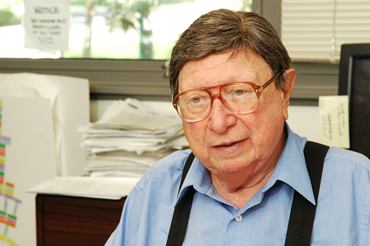 Harold Morowitz
Harold Morowitz
The eminent biophysicist Harold Morowitz died on March 22, 2016, at the age of 88. Morowitz, according to the obituary in The New York Times (April 1, 2016), "was best known for applying thermodynamic theory to biology, exploring how 'the energy that flows through a system acts to organize that system.'" A prolific author, his output included hundreds of papers in biophysics, biochemistry, and molecular biology, as well as scientific books such as Energy Flow in Biology (1968), from which the Times extracted the above passage, and popular books with whimsical titles such as Mayonnaise and the Origins of Life (1985) and The Thermodynamics of Pizza (1991). A final book of his (coauthored with Eric Smith), The Origin and Nature of Life on Earth, is due to be published later in 2016.
Morowitz was among the scientific expert witnesses for the plaintiffs challenging the constitutionality of Arkansas's Balanced Treatment for Creation Science and Evolution Science Act of 1981 in McLean v. Arkansas. Asked to testify about his specialty, biophysics and biochemistry, particularly with respect to the origin of life and the laws of themodynamics, he described creation science's approach to the origin of life as unscientific, citing its misleading probabilistic arguments and misuses of the second law of thermodynamics. (Morowitz discussed his experiences at the McLean v. Arkansas 20 Years Later panel organized by NCSE at the AAAS meeting in 2001; the video is available at NCSE's YouTube channel.) A third of a century later, in 2005, as the trial in Kitzmiller v. Dover neared, he (with Robert Hazen and James Trefil) took a stand against "intelligent design" creationism in the Chronicle of Higher Education, writing (subscription required), "The vast majority of scientists who study the origin of life accept the idea of nonmiraculous origins without any reservations. Only creationists support the theory of intelligent design."
Morowitz was born on December 4, 1927, in Poughkeepsie, New York. A child prodigy, he enrolled at the age of 16 at Yale University, where he proceeded to earn his B.S. in physics and philosophy in 1947, his M.S. in physics in 1950, and his Ph.D. in biophysics in 1951. He then taught in the department of molecular biophysics and biochemistry at Yale from 1955 to 1987. He spent the rest of his career at George Mason University, where he was the Clarence Robinson Professor of Biology and Natural Philosophy and the founding director of the Krasnow Institute for Advanced Study. He was also associated with the Sante Fe Institute, where he served as the Science Board Chair and as the founding editor-in-chief of the journal Complexity, and with NASA, for which he was a consultant on the Apollo 11 and Viking projects.
